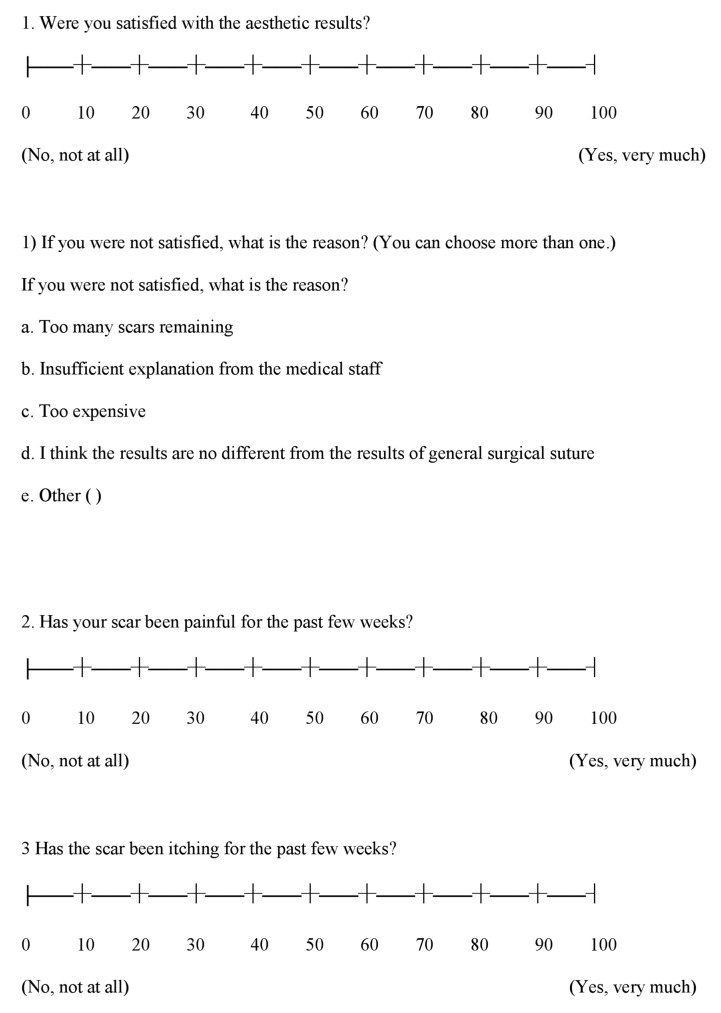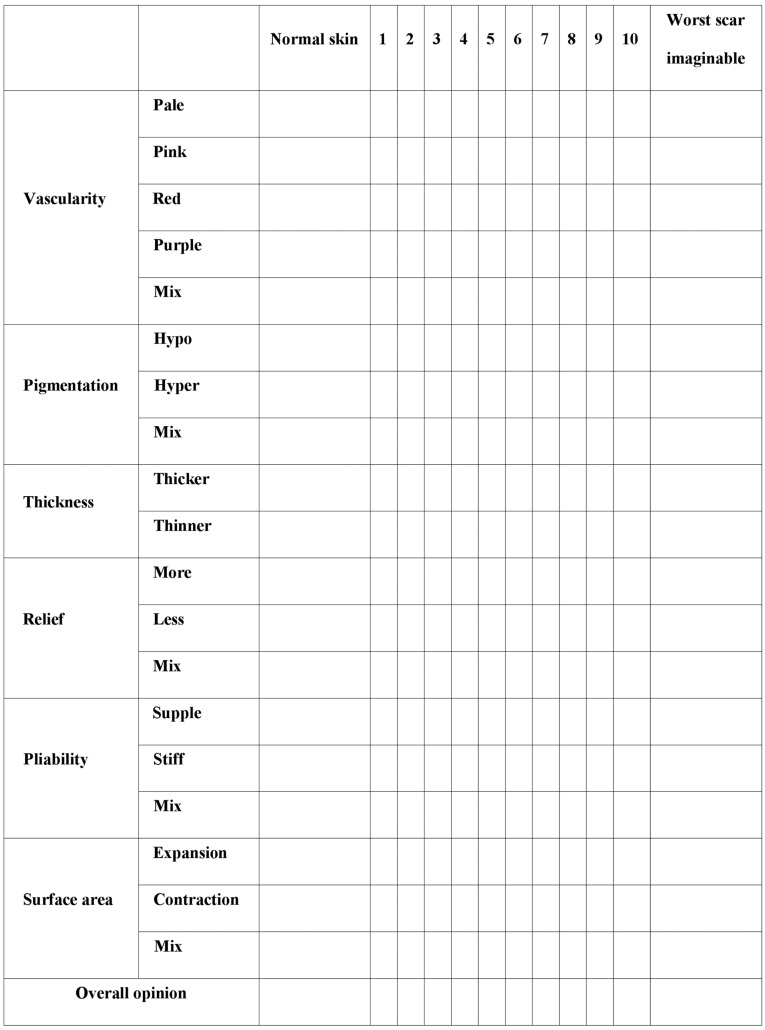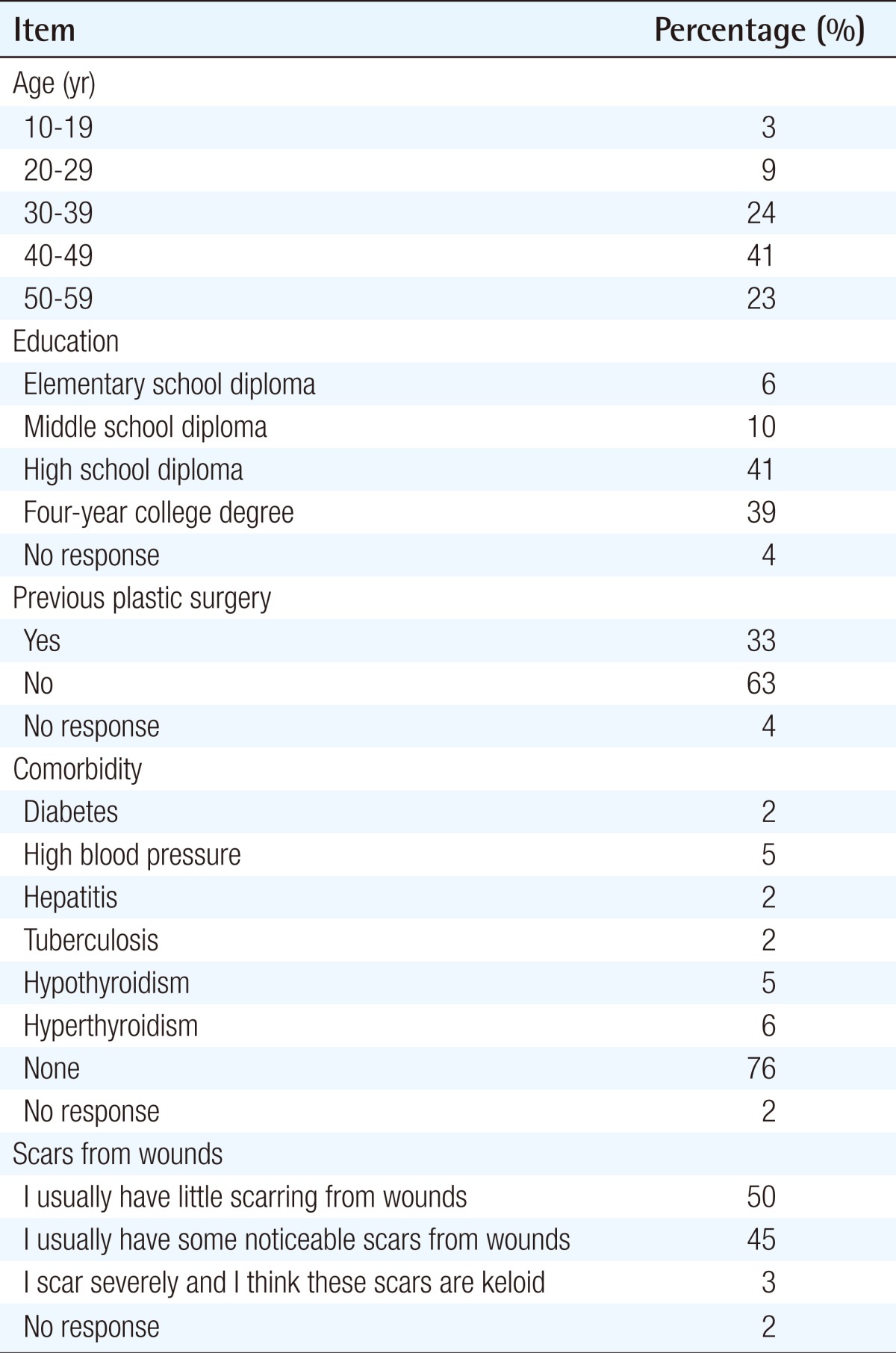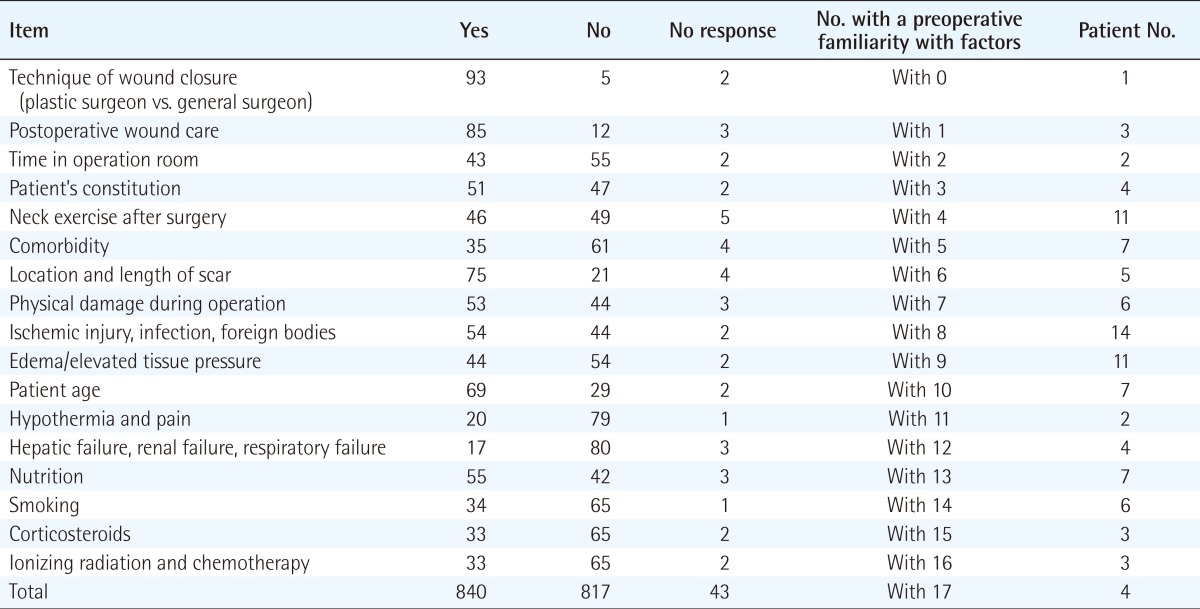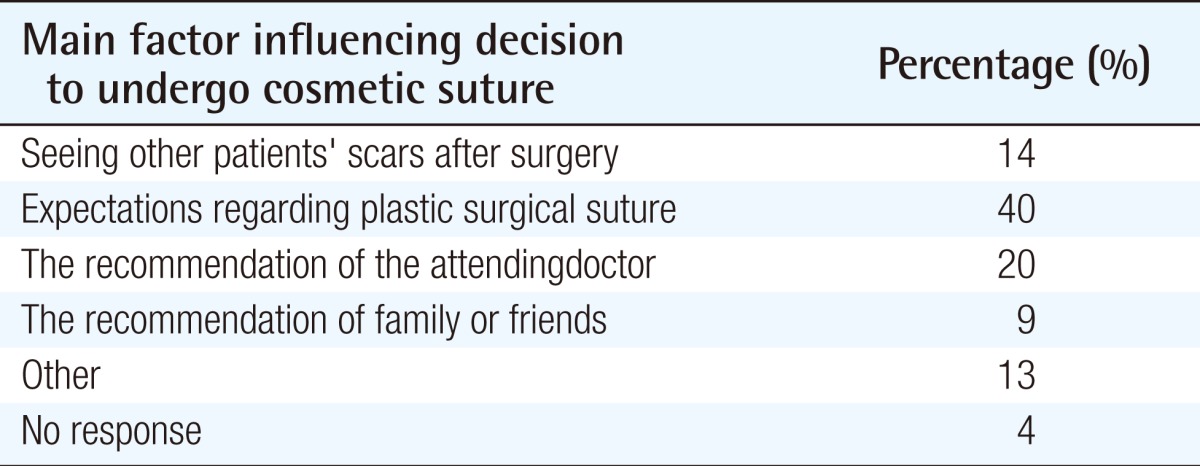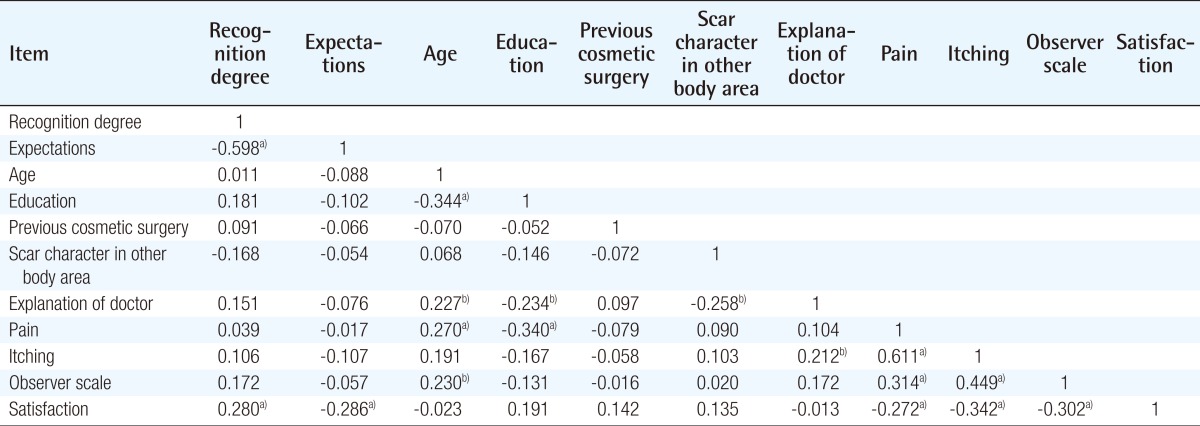Personal Factors that Affect the Satisfaction of Female Patients Undergoing Esthetic Suture after Typical Thyroidectomy
Article information
Abstract
Background
In esthetic surgery, understanding the factors that influence patient satisfaction is important for successful practice. We hypothesize that the factors that influence patient satisfaction include not only aesthetic and functional outcomes, but also personal factors such as the level of familiarity with factors affecting wound healing and expectations regarding aesthetic outcome.
Methods
One hundred patients who underwent esthetic closure after thyroidectomy were included in this study. In order to evaluate the individual characteristics of the patients, a preoperative survey was administered to the patients. We estimated the patient satisfaction six months postoperatively and assessed the aesthetic and functional outcomes using the Patient and Observer Scar Assessment Scale.
Results
According to the results of correlation analysis, level of familiarity with wound healing factors had a positive correlation with satisfaction. High expectations, pain, itching, and high observer scale score had negative correlations with satisfaction. The factors that were correlated with satisfaction were included in the multiple regression analysis. Level of familiarity with wound healing factors was found to have a positive relationship with satisfaction, while itching and observer scale were found to have a negative relationship with satisfaction. After excluding 10 patients who had hypertrophic scars, only level of familiarity with wound healing factors and expectations affected satisfaction.
Conclusions
The level of familiarity with factors affecting wound healing and expectations were found to independently affect satisfaction. Improving patients' level of familiarity with wound healing factors and reducing their expectations by providing suitable preoperative education has the potential to improve patient satisfaction.
INTRODUCTION
Unlike other fields of medicine that use mortality and morbidity rates as a basis for evaluation, patient satisfaction is an important factor in plastic surgery, one that affects quality of life [1,2]. Therefore, it is important to understand the factors that affect the level of patient satisfaction. Understanding these factors may give doctors an opportunity to implement changes to reduce the conditions that adversely influence patient satisfaction.
In plastic surgery, some patients show dissatisfaction despite good aesthetic results. Some patients are dissatisfied due to psychiatric problems, but in most cases, the correlation between patient dissatisfaction and mental condition has not been understood clearly [3]. The authors have experienced low patient satisfaction with esthetic suture in thyroidectomy through transverse cervical incision, even though they were objectively assessed as having had good esthetic results. The authors believed other factors could have influenced patient satisfaction with cosmetic surgery. According to a literature review on patient satisfaction [4], a total of 122 studies on functional and cosmetic aspects as well as all other issues have been reported. Most of the studies were on patients' feelings of satisfaction; however, there were no studies on patients' preoperative levels of familiarity with wound healing factors and patient expectations that influence on the patient satisfaction.
In this study, personal factors that affected the satisfaction levels of patients who underwent esthetic suture in the course of a thyroidectomy through a transverse cervical incision were investigated. The purpose of this study was to identify personal factors that influence patient satisfaction and to provide patients with an appropriate explanation and education before their surgery in an attempt to enhance the level of patient satisfaction.
METHODS
Study subjects
A total of 100 female patients who underwent a thyroidectomy through transverse cervical incision and esthetic suture, performed by the same surgeon between October 2010 and June 2011, were selected for participation in this study. Preoperatively and six months postoperatively, they completed surveys. When they visited the Plastic Surgery Department of the authors' hospital as outpatients before their surgery, they were informed that the suture, the so-called 'esthetic suture,' might be used for cosmetic purposes. Any patients 15 years old or younger, 60 years old or older, or those who had a history of thyroid cancer surgery at the same site or of radiation therapy were excluded from this study.
Study methods
Surveys preoperatively and six months postoperatively
A questionnaire on the personal factors that are thought to influence patient satisfaction levels was designed and administered before the surgery (Fig. 1). The items in the questionnaire included the following: 1) the familiarity level with factors affecting the wound healing process, 2) the expectation level of the results, 3) the reasons for deciding to undergo esthetic suture after thyroidectomy, and 4) demographic factors such as the patient age and education level. For evaluating the familiarity level with factors affecting the wound healing process, 17 factors that could influence the healing process were selected [5], and the patients were asked to select the factors recognized before the survey. At six months postoperatively, the patients' satisfaction levels were evaluated (Fig. 2).

A preoperative questionnaire: personal factor assessment form
Demographic factors, the level of familiarity with factors affecting the wound healing process, the reasons for deciding to undergo esthetic suture, and level of expectation regarding the results were assessed.
Evaluation of other factors that may influence patient satisfaction
To maintain the consistency of the survey, preoperative explanations were made by the same doctor in the same amount of time using the same consent form. Through an additional item on the questionnaire, which asked whether the doctor's explanation was sufficient, the effects of the preoperative explanation were investigated. To evaluate the influence of the esthetic results on the satisfaction level, two plastic surgeons performed scar evaluations using the Patient and Observer Scar Assessment Scale (POSAS) at six months postoperatively (Fig. 3). To evaluate the influence of the functional results, including pain and itching sensations, on the overall satisfaction level, part of the patient scar scale in the POSAS was added to the survey that was conducted six months postoperatively (Fig. 2).
Statistical analysis
A statistical analysis was conducted using SPSS ver. 18.0 (SPSS, Inc., Chicago, IL, USA). The correlation between the personal factors in the preoperative evaluation and the postoperative satisfaction level was analyzed. After selecting statistically significant variables in the correlation, a multiple regression analysis was conducted using the postoperative satisfaction level as a dependent variable. In all the statistical comparisons, significance was recognized with a P-value less than 0.05.
RESULTS
Survey results
Demographic analysis results
The results of the demographic analysis are shown in Table 1. The number of the subjects in each age group was as follows: 41 (41%) in their 40s, 24 (24%) in their 30s, 23 (23%) in their 50s, 9 (9%) in their 20s, and 3 (3%) in their teens. The mean age was 42.61±11.20 years. Most of the patients were high school graduates (41 subjects), followed by college graduates (39), middle school graduates (10), and elementary school graduates (6). Sixty-three subjects had no previous cosmetic surgery experience, and 33 had previous cosmetic surgery experience. Most of the patients did not have a history of any disease (76 subjects), and 6 subjects had suffered from hyperthyroidism and 5 from hypothyroidism. In addition, 50 subjects answered that their scars normally disappeared easily, 45 subjects answered that their scars remained noticeable, and 5 subjects answered that they had keloid lesions.
Evaluation of the level of familiarity with factors affecting the wound healing process, reasons for choosing esthetic suture, and mean level of expectation regarding the results of the esthetic suture
The numbers of subjects who recognized the factors that affected their wound healing process by item were as follows: 93 recognized the suture method; 86, postoperative wound care; 75, the location and length of the incision; 69, age; 55, nutritional condition; 54, ischemic damage, foreign objects, infection, and inflammation; 53, physical tissue damage during the surgery; 51, the uniqueness of their physical constitution (i.e., keloids); 46, practice of postoperative neck exercise; 44, edema immediately after the surgery; 43, operation time; 35, chronic diseases such as diabetes; 34, smoking; 33, intake of drugs such as steroids and hormones; 33, postoperative radiation and chemotherapy; 20, hypothermia and pain; and 17, liver, kidney, and respiratory failure. The mean number of factors recognized preoperatively as influencing the wound healing process was 8±4.1 (Table 2).
Most (40) of the subjects decided to undergo esthetic suture due to their expectations, followed by the recommendations of their doctors (20), the results of other patients (14), and the recommendations of their family and acquaintances (9) (Table 3).
The mean expectation level with regard to the results of the esthetic suture was 73.5±24.1. Sixty-five subjects reported that the doctor's preoperative explanation was sufficient, whereas 34 subjects responded that it was insufficient (Table 4).
Satisfaction level with the postoperative esthetic suture and pain and itching sensation scores
The satisfaction level with the postoperative esthetic suture was 58.9±24, the pain score was 15.3±22.1, the itching sensation score was 15.2±21.7, and the observer scale was 17±3.5 (Table 5).
Correlation analysis
The correlation analysis showed that the coefficient of the correlation between the familiarity level with wound healing factors and the satisfaction level was 0.28, which revealed a significant positive correlation (P<0.01). The coefficients of the correlations between the satisfaction levels and the respective expectation levels, pain sensation, itching sensation, and observer scales were -0.286, -0.272, -0.342, and -0.302, respectively, which all showed significant negative correlations (P<0.01, P<0.01, P<0.05, and P<0.01, respectively). The absolute correlation coefficient value of the itching sensation was the highest, followed by those of the observer scale, pain, expectation regarding the results, and level of familiarity with wound healing factors. Since the correlation coefficient of having an itching sensation and pain was quite high at 0.611, multicollinearity was a clinical possibility. Accordingly, pain, which had a low correlation coefficient, was excluded from the multiple regression analysis. No significant correlations were observed between the satisfaction level and demographic factors, such as age or education level, nor with the reasons for deciding to undergo cosmetic surgery (Table 6).
Multiple regression analysis
As a univariate analysis, a multiple regression analysis was conducted using statistically significant variables, including the familiarity with wound healing factors, the expectation level of the results, itching sensation, and the observer scale as independent variables and the satisfaction level as the dependent variable. As a result, the standardized coefficient (β) of the familiarity level with wound healing factors was calculated as 0.311; and with an increase in the number of factors, the satisfaction level also increased with statistical significance (P=0.008). The standardized coefficients (β) of the itching sensation and the observer scale were -0.292 and -0.279, respectively; and with the increase in these values, the satisfaction level decreased with statistical significance (P=0.007 and P=0.009, respectively). The level of expectation regarding the results did not significantly affect the satisfaction level (P=0.143) (Table 7).
Multiple regression analysis after excluding subjects who developed hypertrophic scars
We hypothesized that the factors affecting the level of satisfaction would differ between patients who had a hypertrophic scar and those who did not. Therefore, we ran a multiple regression analysis comparing patients with and without hypertrophic scarring.
The standardized coefficient (β) of the familiarity with wound healing factors was 0.325; and with an increase in the number of factors recognized, the satisfaction level also increased with statistical significance (P=0.005). The standardized coefficient of the expectation level of the results was -0.284; and with the increase in the expectation level, the satisfaction level also decreased with statistical significance (P=0.011). The observer scale and itching sensation did not significantly affect the satisfaction level (P=0.109 and P=0.113, respectively) (Table 8).
DISCUSSION
According to Ware et al. [6], the factors that affect patient satisfaction include interpersonal manner, technical quality, accessibility/convenience, finances, efficacy/outcomes, continuity of care, physical environment, and availability of care and resources. Clapham et al. [4] modified Ware's taxonomy to make it applicable to the field of plastic surgery; they classified the factors that affect patient satisfaction after cosmetic surgery into three groups: provider-related issues, efficacy/outcome, and all other issues. The efficacy/outcomes were classified into three factors: the aesthetic outcomes, the functional outcomes, and the psychological outcomes. In addition, they conducted a literature review on 178 studies with regard to the factors that affect the patient satisfaction level after plastic surgery. They found that most studies were about cosmetic and functional factors, with the remainder focusing on the general feeling of satisfaction.
In conceiving this study, the authors suspected that, other than the aforementioned factors, there might be personal factors that affect the satisfaction level. In particular, in this study, not only the preoperative familiarity level with wound healing factors, the level of expectation regarding the surgery results, and the reasons for deciding to undergo esthetic suture were investigated, but also demographic factors such as age and education level, in order to evaluate the influences on the satisfaction level. In this study, age did not affect satisfaction. Chung et al. [7] conducted a study on the prognosis of plastic surgery outpatients and reported that the patient age did not significantly affect satisfaction level. This conclusion coincides with that of this study. In this study, most of the subjects were high school graduates, followed by college graduates and middle school or lower school graduates. According to a study that reported on the expectations of patients regarding orthognathic surgery [8], the satisfaction level did not show differences according to education level; and in the aforementioned studies, the education level likewise did not affect the satisfaction level. The perceived sufficiency of the doctor's explanation did not significantly affect the satisfaction level. This might have been because the explanation was repeated by the same doctor in all cases and the satisfaction level was evaluated six months postoperatively.
The correlation analysis in this study showed that the level of familiarity with factors affecting wound healing; the expectation level of the results; pain; itching sensation; and the observer scale were significantly correlated with the satisfaction level. The multiple regression analysis showed that the level of familiarity with factors influencing the healing process, the itching sensation, and the observer scale independently affected the satisfaction level. The independent evaluation of the expectation regarding the results in relation to the other factors showed that they did not significantly affect the satisfaction level. In clinical situations, the functional and aesthetic results are important factors that affect the level of satisfaction with cosmetic surgery. The satisfaction level seriously deteriorates when a hypertrophic scar develops, and the aesthetic and functional results are significantly worse than compared with those of normal scars [4,9]. Therefore, the authors thought that the factors that affect the satisfaction levels of hypertrophic scar patients might differ from the factors that affect the satisfaction levels of patients with flat and linear scars but without hypertrophic scars. To investigate the factors that affect the satisfaction levels of patients without hypertrophic scars, ten hypertrophic scar patients were excluded from the multiple regression analysis. Only the familiarity level with wound healing factors and the expectation level of the results were confirmed to have affected the satisfaction level. In this study, the functional and aesthetic results, such as the itching sensation and the observer scale, significantly affected only ten hypertrophic scar patients. Therefore, the satisfaction levels of most of the patients may not have depended only on cosmetic and functional factors. This is considered an important fact that plastic surgeons, who tend to concentrate on the aesthetic results of cosmetic surgery, should keep in mind. According to the studies on patient satisfaction conducted by Olson and Laskin [8] and Mira et al. [10], doctors' explanations of the anticipated surgical process, the completed surgical process, and the follow-up management significantly affected the level of satisfaction. Therefore, detailed preoperative explanations of the wound healing process may enhance the familiarity with factors that affect the process, and adjusting any unreasonable expectation levels may enhance patient satisfaction. This result is considered to apply not only to patients who undergo esthetic suture after typical thyroidectomy, but also to general cosmetic surgery patients. As for other types of cosmetic surgery, recognition of the factors that affect the results of the surgery may need to be enhanced.
In multiple regression analysis, to determine the factor that most affected the satisfaction among 4 factors (familiarity with wound healing factors, expectations, observer scale, itching), standardized coefficients were used because standardized coefficients represent the relative influence among the 4 factors that explain satisfaction. That the standardized coefficients were differentiated according to the 4 factors means that when the 4 factors had a simultaneous effect, the factor that had the highest standardized coefficient influenced satisfaction the most.
For this study on the factors that affect the patient satisfaction level after cosmetic surgery, patients who underwent esthetic suture after typical thyroidectomy through transverse cervical incision were selected. This is because, unlike other cancer patients, most thyroid cancer patients are young, the majority of the patients are female, the postoperative incision site is not covered with clothing [11], and the patients and their families are very sensitive to scars because thyroidectomy is not life-threatening despite being a cancer surgery [12-14]. In the authors' hospital, more and more patients, especially young female patients, elect to undergo esthetic suture after thyroidectomy. In this study, the general factors, including the surgeons, and the cosmetic, functional, and mental factors that can affect the satisfaction level, were better-controlled for than those in other types of cosmetic surgery. Accordingly, it is believed that the influence of personal factors, such as the patient's preoperative expectations of the postoperative satisfaction level were well investigated in this study.
The items in the preoperative survey were devised to evaluate the personal factors that we hypothesized would have an effect on patient satisfaction (demographics, level of familiarity with factors affecting the wound healing process, reason for choosing aesthetic closure, expectation level of the result, level of preoperative explanation). Among those factors, factors that would affect wound healing were designed to include both local factors and systemic obstacles [5]. The items in the postoperative survey were designed to evaluate cosmetic and functional results as well as the level of patient satisfaction. Since the cosmetic and functional results significantly affect the satisfaction level, an exact evaluation of the factors is important. In this study, the POSAS was used to evaluate the cosmetic and functional results. This method is deemed useful for linear scar evaluation and burn scar evaluation [15,16]. Patients may have more diverse problems than observers recognize, and their own perspectives can influence their quality of life [17]. Functional factors, such as itching sensation and pain, have usually not been evaluated by observers, but they were evaluated in this study using a patient scale, along with the effects of the functional factors on the satisfaction level.
The limitation of this study was that not all the factors that affect the satisfaction level were considered. In an attempt to include as many factors that affect the satisfaction level as possible, cosmetic and functional factors were evaluated. In the multiple regression analysis where the familiarity with factors affecting the wound healing process, the expectation of the results, itching sensation, and the observer scale were independent variables and the satisfaction level was a dependent variable, the adjusted coefficient of determination was calculated to be 0.242. Accordingly, the integrated effect of the independent variables on the satisfaction level was 24.2%. In the analysis without the hypertrophic scar patients, the effect of the independent variables on the satisfaction level was only 27.2%. This implies that there may be items that significantly influence the satisfaction level other than those that were used in this study. In future studies, these factors may need to be added and evaluated to enhance the satisfaction level.
In conclusion, when the hypertrophic scar patients were excluded, the functional and esthetic results did not affect the satisfaction level; and with an increase in the familiarity with the factors that affect wound healing and decrease in the level of expectation regarding the results, the postoperative satisfaction level improved. Therefore, regardless of the cosmetic and functional results (except with respect to hypertrophic scar patients), sufficient preoperative explanation of the results of cosmetic surgeries and adjustment of the expectation level may contribute to enhanced postoperative patient satisfaction.
Notes
This article was presented at the 70th Congress of the Korean Society of Plastic and Reconstructive Surgeons on November 10, 2012 in Seoul, Korea.
No potential conflict of interest relevant to this article was reported.
